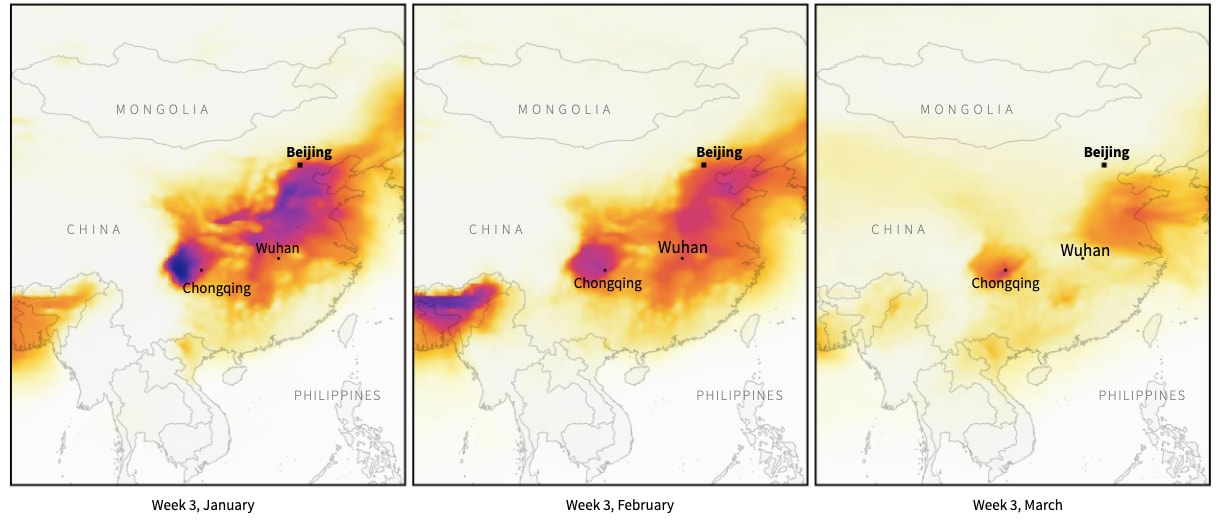This is the effect coronavirus has had on air pollution all across the world

There has been a dramatic reduction of smog in India since the lockdown started. Image: REUTERS/Sunil Kataria

Explore and monitor how COVID-19 is affecting economies, industries and global issues

Get involved with our crowdsourced digital platform to deliver impact at scale
Stay up to date:
COVID-19
- The coronavirus pandemic has lead to an increase in air quality all around the world. Lockdowns have resulted in factories and roads shutting, thus reducing emissions.
- These 11 visualizations, using data from NASA’s Global Modeling and Data Assimilation team, show the dramatic impact lockdown measures have had on pollution levels.
To contain the coronavirus pandemic, billions of people have been told to stay at home. In China, authorities placed almost half a billion people under lockdown, the equivalent of nearly 7% of the world’s population. Many other countries have since taken similar measures, initially in hard-hit Italy and Spain, and more recently in the United States and India.
The restrictions have sent financial markets into free fall. But they have also given residents in some of the world’s most polluted cities something they have not experienced in years: clean air.
Reuters visualisations, based on data from NASA’s Global Modeling and Data Assimilation team, show how concentrations of some pollutants fell drastically after the lockdowns started.
Satellite observations record information on aerosols in the atmosphere. NASA’s model is then able to provide estimates of the distribution of these pollutants close to the Earth’s surface.
China
The maps below show how levels of PM2.5 nitrate fell in China’s Hubei province after the government imposed travel restrictions. Nitrate is one of the components that make up PM2.5, tiny particles, about 3% of the diameter of human hair, that can penetrate deep into the lungs and enter the bloodstream, leading to heart disease, strokes or cancer.
Nitrate aerosols are formed from nitrogen compounds, which can be emitted by human activities, especially burning fuel and diesel.


“We may soon learn how much of an impact this temporary pause in pollution has had on human health and the environment, but the clearest takeaway from this event is how satellite measurements of nitrogen compounds can be used as an indicator of economic activity,” said Ryan Stauffer, a research scientist at NASA’s Goddard Space Flight Center.
Ground station metrics from Wuhan, where the pandemic originated, show how certain pollutants including nitrogen dioxide were at record lows during the first few months of the year.
Some of the major sources of nitrogen dioxide are vehicle exhausts, power plants and wastewater treatment plants.
Scientists say nitrogen dioxide pollution has been steadily decreasing over the last few years. However, the lockdown may have contributed to this year’s drop.
The following charts show monthly averages of pollutants over the last seven years.

South Korea
In early March, South Korea reported a large increase in COVID-19 cases. Since then, ground stations have been measuring the lowest levels of some pollutants for seven years. Although South Korea did not impose major restrictions on residents, changes in daily activity could have contributed to the drop.

Italy
Similar patterns unfolded across Italy following the introduction of a nationwide lockdown on March 9. Restrictions had already been implemented in late February in some northern regions, where COVID-19 cases had surged.
The industrial belt across northern Italy often experiences high levels of air pollution, but estimates show otherwise this year.


Of the pollutants that fell most significantly in northern Italy, nitrogen dioxide stood out, according to data recorded at ground stations. Bergamo, one of the provinces most affected by the virus, has experienced improvements in air quality.

India
Every winter, New Delhi and other big cities in the north are enveloped in a blanket of smog as farmers burn crop residue. The air tends to clear a little in spring.

However, in the first few months of this year, India experienced a significant decline in some pollutants. The lockdown imposed by Prime Minister Narendra Modi on the country’s 1.3 billion people could be a major contributing factor. However, there may also be other factors impacting air quality, according to Pallavi Pant, an air quality scientist at the Health Effects Institute in Boston.
“Air pollution levels are often influenced by local meteorology, like temperature or wind speed. Several early analyses are showing declines in air pollution in regions where shutdowns have taken place. However, any such analyses should consider all relevant factors.” Pallavi Pant told Reuters.
Ground stations in northern India also show a downward trend in overall PM2.5, according to data from local authorities.

Beyond improvements in outdoor air quality, scientists are also curious how lockdowns have affected indoor air quality, with millions of people staying at home for far longer than usual.
“As we continue to talk about improvements in outdoor air quality, people are spending a lot more time indoors and the exposure patterns for indoor air pollution might be different at this time too,” said Pant.
Don't miss any update on this topic
Create a free account and access your personalized content collection with our latest publications and analyses.
License and Republishing
World Economic Forum articles may be republished in accordance with the Creative Commons Attribution-NonCommercial-NoDerivatives 4.0 International Public License, and in accordance with our Terms of Use.
The views expressed in this article are those of the author alone and not the World Economic Forum.
Related topics:
The Agenda Weekly
A weekly update of the most important issues driving the global agenda
You can unsubscribe at any time using the link in our emails. For more details, review our privacy policy.
More on COVID-19See all
Charlotte Edmond
January 8, 2024
Charlotte Edmond
October 11, 2023
Douglas Broom
August 8, 2023
Simon Nicholas Williams
May 9, 2023
Philip Clarke, Jack Pollard and Mara Violato
April 17, 2023





